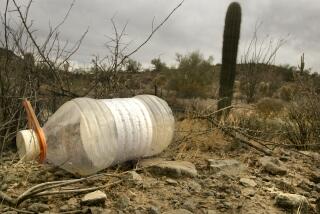Desert Encroachment : Fabled Oasis of Timbuktu Is Drying Up
TIMBUKTU, Mali — Word of this mysterious oasis at the edge of the Sahara Desert reached the civilized world on the backs of camels. The river here ran deep with cool water, it was said; the trees were heavy with lemon and mango, the markets gleamed with gold, and the university was bursting with vitality.
Here in the middle of Africa, circa 1500, was a place, still unseen by Europeans, where one could find “doctors, judges, priests and other learned men bountifully maintained at the king’s cost,” as one Arab traveler put it.
Timbuktu, 20 days’ crossing over the bleak sands of the Sahara, marked the end of the Sahara and the beginning of the fertile savannah. Here, the Arab and African worlds met on the banks of the Niger River, bartering the desert’s salt for the jungle’s gold.
Lost Its Luster
In time, Timbuktu lost its luster.
These days, it is losing much more. The advancing desert has tied a noose of sand dunes around this legendary city. The maze of sandy streets and mud-hewn mosques is clogged with refugees, the cisterns are increasingly dry and gardens are bare. Timbuktu is slowly dying.
A sign welcoming visitors to “The Pearl of the Desert” nearly disappears in a sand-laden wind. The storied remoteness grows. The river has shifted 15 miles away and, in any case, is navigable only a few months a year. No tarmac road, no rail line ever reached Timbuktu. These days, a few relief workers come by small plane.
Timbuktu is probably the world’s best-known victim of the steady and irreversible growth of desert land on the planet. Each year, on continents as far flung as South America, Asia and Africa, nearly 15 million acres of once-productive soil--an area half the size of Kentucky--become an unrecoverable wasteland.
Although scientists believe this desertification may be in part the result of long-term climatic changes, they blame man for sharply accelerating the land degradation. The unbridled growth of human and animal populations on land too fragile to support them, along with increasingly frequent droughts, has swiftly turned these areas around Timbuktu to desert.
“What nature used to do in several thousand years, man is doing in 20,” said Monique Mainguet, deputy director of the United Nation’s Desertification Control Program, headquartered in Nairobi, Kenya.
The largest area in the world threatened by desertification is the Sahel, a region of six West African countries that sits along the southern edge of the Sahara Desert and includes Timbuktu. It is one of the poorest places in the world, with an average annual per-capita income of less than $400.
Hundreds of millions of dollars have been spent to stop the encroaching desert here. Yet success stories are rare. So far, by common agreement, the overall effort has been a colossal failure. The desert rolls on.
Most international relief agencies operating in Mali no longer talk about saving the 150-mile-wide strip of land next to the Sahara, where places such as Timbuktu receive too little rain--about 8 inches a year--for growing crops. Instead, officials consider the lands further south, which are still fertile but seriously overpopulated, as the only logical, and economical, line of defense against the encroaching desert.
‘Too Late for Timbuktu’
“It’s too late for places such as Timbuktu,” a Western relief official in the Malian capital, Bamako, said recently. “From a humanitarian point of view, there is a responsibility. From a development point of view, you’re sinking a lot of resources into something that cannot be sustained.”
Just a decade ago, Timbuktu did not even look as if it needed saving.
“I wish you could have seen my garden in 1975,” a businessman here said not long ago. “We had lemon trees, date palms and beautiful flowers. Now there is not a living thing left.”
The most unusual feature of the Timbuktu skyline is a water tower, rising about 75 feet above the flat-topped mud homes. That tower, appearing low in the sky on waves of heat, is a pleasing sight for caravans arriving after a month on the desert. But it might as well be a mirage.
Water Table Dropped
Timbuktu has more than 40 cisterns; all are empty. As recently as 1983, some trenches in town regularly had standing water after a rain shower. But the water table has dropped steadily. Today wells here must sink 200 feet for water.
Firewood is even scarcer. The sand and soil outside of town have been scoured clean of any such fuel. A few days ago, two young boys were trudging from tree to scrubby tree, a dozen miles from civilization, stuffing their small harvest of valuable sticks into burlap bags slung on their backs.
Collecting firewood without a license is illegal in Mali, but that law is impossible to enforce in these vast uninhabited spaces, where international relief agencies need local guides to help find their project sites from day to day.
Once Cattle Grazed
Timbuktu was once ringed with grassland, and for centuries the blue-robed Tuareg nomads found these parts ideal for grazing cattle. But overgrazing of this already marginal land took a toll, and when droughts struck a decade ago, killing several hundred thousand people and millions of cattle, the Tuareg life style began to disappear.
Many nomads moved their dome-shaped tents to the edge of Timbuktu, swelling the city’s population from 23,000 to 35,000. A few Tuareg nomads tried their hand at business, and the number of stores grew from 30 in 1975 to 300 today.
But now “the economy of the region has collapsed,” Addas Fouad Abdel Kader, 52, the mayor of Timbuktu, said in a recent interview. “Everyone is getting poorer and poorer.”
Decline in Leading Export
The mayor is no exception. His business is collecting and exporting gum arabic, which is widely used for pharmaceuticals and candy. Mali once was one of the world’s largest exporters of gum arabic, and this area was especially productive because the acacia trees from which it is obtained flourished in places that used to be flooded several months a year.
Back in 1974, Kader collected 400 tons of the gum. Ten years later, he only managed to bring in 20 tons. Last year, it was down to 300 pounds.
This year, the mayor said recently, “I haven’t found a kilo yet. The trees are dead.”
For the first time in several years, though, food is not a particular worry this winter in Timbuktu. Mali’s delta region, about 100 miles south of here, had a good harvest and there is also leftover rice from international donations made during the 1984-85 drought. But the slightest lessening of rainfall anywhere in the country would imperil thousands here.
Reminders of City’s Glory
The Timbuktu market carries some grain, spices and a thick brown cooking oil made from peanuts. The market women also have a few trinkets of gold and silver that they sell to out-of-town visitors, small reminders of the city’s glory days.
Vegetables are grown in small garden amphitheaters in the city, with the plants arranged in concentric circles around a well that is drilled in the sand. Under the sun, which can send temperatures as high as 125 degrees, butchers in blood-stained white coats chop slabs of beef and weigh them on rusty metal scales.
Many here blame Timbuktu’s troubles on its isolation, which a few centuries ago was the city’s virtue.
“You see, in Timbuktu, the principle problem is (that) there is no way out,” said Mohammed Ali, a lifelong resident. “There is just sand between us and the rest of the world. To get development you have to first get a good road.”
Once Legendary
Once, the difficulty of reaching Timbuktu helped make its name a legend. Many European explorers died at the hands of the nomads, or simply of thirst, in their attempts to reach here. One of the first Europeans to lay eyes on the place and live to tell about it had to disguise himself as a nomad. He penetrated this secret Islamic culture in 1828, more than 100 years after Timbuktu had ceased to be a renowned center of trade and academe.
Given the steady deterioration of this region, it is unlikely that the Mali government or anyone else will invest in a road to Timbuktu, which is more than 400 miles northeast of the capital, Bamako.
For a time, Air Mali operated a four-stop, weekly flight that included Timbuktu, the regional center for northern Mali. Officials here, hoping for an influx of tourists to see the fabled city, built a small, European-run hotel.
But the Air Mali plane crashed as it attempted to take off from here in 1985, killing 52 people. The tourist trade never boomed. Several hundred visitors do come every year now, but most of them have friends with relief agencies or embassies in Bamako.
Travel by Camel Still Popular
The surest way to get to Timbuktu is, and always was, by camel. Small, chartered planes and four-wheel-drive vehicles also are used. The weeklong journey by boat from Bamako to Timbuktu was fairly popular until a few years ago, when the shifting sands moved the Niger River, leaving this port of call abandoned. A paved road now connects the river with Timbuktu, but the water level is too low for boats during most of the year.
A few camel caravans still bring 100-pound slabs of salt from the mines near Taoudenni, in far northern Mali, to Timbuktu and points south. But they only come when the salt can be sent down the Niger. Even then, the caravans must camp far from Timbuktu to find forage for the camels.
“It’s depressing, what has happened to Timbuktu,” said Mossadeck Bally, 27, a Bamako businessman who grew up in Timbuktu.
Bally, who studied at the University of San Francisco, remembers a childhood spent swimming in the canals here and playing soccer at night on brightly lit streets while dozens of tourists watched. Timbuktu’s streets are dark at night now; electricity comes from expensive oil-burning generators rather than running water.
Was Nearly a Savannah
“In those days, we had rain in the rainy season,” Bally recalled. “Timbuktu was the beginning of savannah. Now it’s become the last place where you can still see a tree or two before the desert.”
Another man who went to high school in Timbuktu 20 years ago remembers afternoon barbecues, with plenty of beef, watermelon, salads, tomatoes--and firewood. He also recalls having to stop for herds of giraffe and antelope while driving near Timbuktu.
“It was a wealthy place, but that has vanished,” he said, citing as an example the shrinking size of the dowries that the young men of Timbuktu paid for their brides-to-be. “People are getting married almost for free,” he added.
The charm and mystery of Timbuktu has yet to disappear, however.
A rich Arab architectural heritage hides beneath the dust of time. Many earthen homes still have intricate door carvings. The city’s orderly courtyards open up when viewed from the top of the cool, dark mosques where Islamic scholars debated the issues of the day and filled libraries with rare books before invading Moroccans jailed all the intellectuals in the late 1500s.
Ghost Stories
When Mossadeck Bally was a child, he and his playmates thought the streets here were haunted with the ghosts of those authors, traders and marauding nomads.
“Our parents warned us to beware of meetings with bad spirits or angels,” Bally said. “No matter how old you get, or how intellectual you are, the mere fact that you’re in those streets makes you obliged to partially believe the stories.”
Desertification officials take a longer view of history when talking about Timbuktu. Some 20,000 years ago, the desert stretched several hundred miles south of here, they say. By the time Timbuktu was founded, in 1100, the climate and the terrain had become more hospitable.
Most scientists believed the desert would eventually have returned here anyway. But they say that the pressure of population and economic growth have accelerated the destruction of the land. The resulting moonscape, they say, is probably triggering even more severe climatic changes.
Temporary Relief
Small things can be done to halt desertification in specific cases. Dune stabilization, erecting windbreaks, tree planting and encouraging the use of fuel-efficient stoves have been successful in some areas. Digging wells, helping residents irrigate marginal lands and teaching nomads to farm also has provided some temporary relief.
But scientists and relief officials debate the wisdom of such projects. Some believe those efforts encourage people to stay in areas that they would be better off leaving. That is why many aid agencies are concentrating their efforts on areas south of here, where people already are using manure and sorghum stalks for firewood.
“We should make that the front line of the battle against desertification,” a Western aid official said.
What, then, will become of Timbuktu?
‘Good Luck’ Wish
When Bob Geldof, the Irish pop singer who raised millions for famine relief in Ethiopia, was asked to sign the Timbuktu guest book during a 1984 visit here, he wrote: “Good luck. You need it.”
Mayor Kader says all Timbuktu needs to do is raise the water table and build a transportation link.
“The desert just keeps gaining ground,” he said, “but I don’t think either Mali or the world community would let Timbuktu die.”
Most experts agree. The white, four-wheel-drive vehicles of U.N. aid agencies are still here, fishtailing through the streets, and dozens of relief projects are under way.
“Timbuktu will still be here in 20 years, with more misery and more people begging in the streets,” a top relief official in Bamako said recently. “If the trend continues, Timbuktu will not be so much a tourist place as a refugee camp.”
More to Read
Sign up for Essential California
The most important California stories and recommendations in your inbox every morning.
You may occasionally receive promotional content from the Los Angeles Times.











